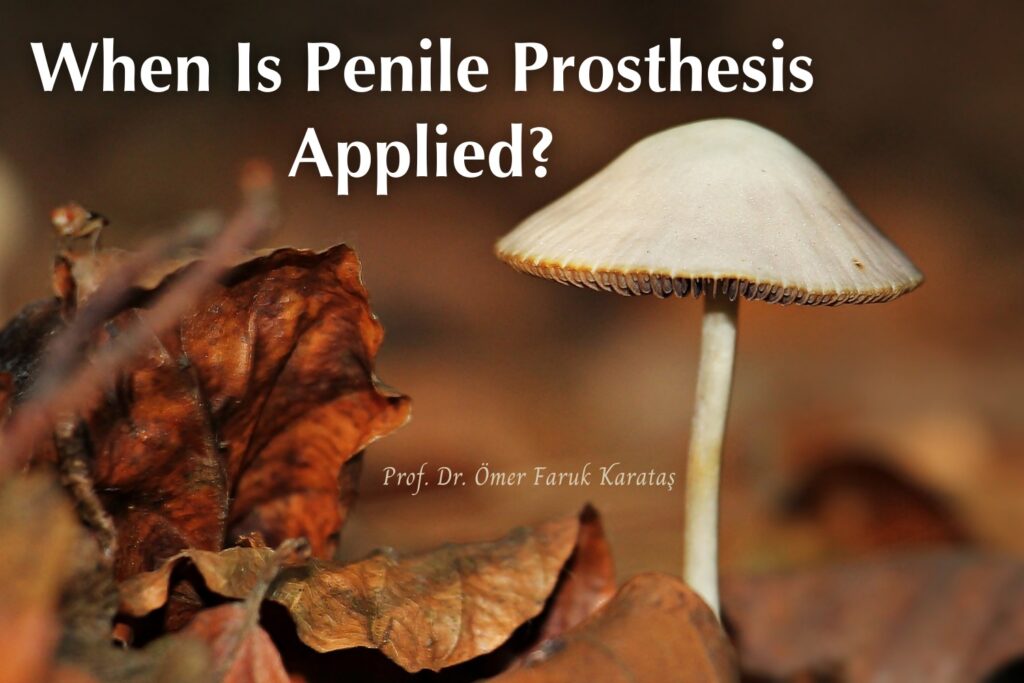Penile prostheses, which are called happiness sticks among the people, are a treatment method applied with a surgical operation in order to eliminate the erection problem.
This treatment is a permanent solution applied in case of failure to respond to treatments such as erection pills, vacuum devices, injection therapy.
The situation where the penis cannot reach or maintain sufficient hardness, especially during sexual intercourse, is called erectile dysfunction. Erectile dysfunction is not a disease in itself and is a condition that can occur due to other diseases.
In such a case, the inserted penile prosthesis makes it possible to maintain the ideal penile hardness during sexual intercourse.
When is penile prosthesis applied?
Penile implants, which are frequently preferred among urological prostheses used to eliminate erectile dysfunction that may occur in the male reproductive system, play an important role in maintaining the activeness of sexual life.
These prostheses, which are used in erection problems that may occur due to age, chronic diseases and lifestyle, and in cases where other treatment methods do not work, can be easily applied by surgical methods.
In order to use urological prostheses, it is a very important criterion that the patient has tried all other known treatment methods and has not been successful. The results of this surgical procedure are quite satisfactory for both the patient and his partner.

Which prosthesis is the most ideal for which patient?
The types of prostheses commonly used today are usually single or three-piece. One-piece prostheses are rod-shaped and have a flexible but rigid body that can be bent.
The one-piece penile implant can be used during sexual intercourse by manually turning it into an upright position. Afterwards, it is manually returned to its original position and can be hidden inside the underwear.
The three-piece penile prosthesis, on the other hand, has a pump and reservoir mechanism with cylindrical parts that do not create a feeling of permanent hardness.
As a result of squeezing the pump placed in the testis several times, the liquid in the reservoir enters the cylindrical parts and provides hardening in the penis. In order to end the hardening in three-piece prostheses, the lowering button on the pump in the testis is used.
Three-piece inflatable penile prostheses are not suitable for people who have hand-to-body coordination problems, advanced Parkinson’s disease, or those who will not use an activator pump due to their body structure.
According to this:
- Multi-piece prostheses are more suitable for young patients.
- Multi-piece prosthesis should be preferred for diabetic patients if the patient is young and their intellectual level is appropriate.
- One-piece penile prostheses are more suitable for more elderly patients.
- One-piece prosthesis is more suitable for elderly or patients who cannot use their hands to use a multi-piece prosthesis.
- One-piece is preferred for those who cannot afford a multi-piece prosthesis for economic reasons.
- One-piece prostheses are also more suitable for patients with spinal cord trauma (paralysis in their legs) and who cannot use their hands well.
Preparation for penile prosthesis implantation
Before deciding on penile implant surgery, it is very important to perform a general examination of the patient, both urologically and physically.
The inability of the patient to get results from other psychological or physiological methods and the inability to solve the erection problem with different solutions necessitate surgical intervention in a sense.
In some cases, urological implants may be partially rejected by the patient’s body after the operation. In some cases, penile prosthesis surgery may cause different complications. Which type of implant model will be used is closely related to the success of the surgery as well as the development of the patient’s hand skills.
It is important to give detailed information to the patient before the operation and to decide on the operation after all the examinations are completed.
Penile prosthesis implantation
Prosthetic surgery is an effective treatment method preferred in people who do not get enough benefit from other treatments in erectile dysfunction. However, before the surgery is performed, it is necessary to determine whether individuals are suitable for surgery. For this, first of all, inspection and tests are done.
Routine blood tests and imaging modalities such as ultrasound may be used. The type and dimensions of the penile implant to be used are determined according to the anatomical structures of the patients who are suitable for surgery.
Although the surgery is mostly performed with general anesthesia, some prosthetic surgeries can also be performed by spinal anesthesia. A catheter is placed in the bladder area to drain the urine accumulated in the bladder during the surgery.
During one-piece penile prosthesis surgery, a small incision is made under the penis and the prosthesis is inserted into the cavities in the penis. This surgical procedure is completed in approximately half an hour.
The procedure is a little more complicated for three-piece prostheses. While the pump part is placed in the testis and the reservoir part is placed in the abdomen, the cylinder parts of the prosthesis are implanted into the cavities in the penis. This process takes 1-3 hours on average.
What should be considered after penile prosthesis surgery?
Penile prosthesis surgeries are operations that take a much shorter time than it is thought and the healing process is completed quite quickly. However, as with any surgical intervention, it is quite normal for the patient to feel pain for a certain period of time.
The mild pain felt may last for several weeks in some cases. In order to prevent infections that may occur after the surgery, it is of great importance that the antibiotics given by the doctor are used regularly.
Many patients were able to return to routine physical activity and sexual life easily within 4-6 weeks after the operation. In order for the use of urological implants to become practical and for the patient to get used to the use of prostheses more easily, regular daily exercise is among the factors that the doctor may recommend.
Who is the implant not suitable for?
Penile implants, which are the most current and permanent solution for erectile dysfunction, are not suitable for some patients. This application is not preferred especially in patients with chronic diseases and various infections.
Accordingly, the following groups of patients are not fitted with a penile prosthesis:
- It is not preferred in cases that do not really have erectile dysfunction, are temporary or occur due to the conditions of the person and are likely to recover.
- If there is an active scrotal skin infection, the penile prosthesis is not inserted.
- If there is an active urinary tract infection, the penile prosthesis is not inserted.
- It is not suitable for those with severe diabetes that is not well controlled.
- These implants are not placed on people who are mentally unstable and have serious psychological problems.
- It is not recommended for men who are unmarried or not having a chance to have a regular relationship.
It is also important to know that the penile prosthesis will not increase the length of the penis and will not positively affect sexual pleasure.
What are the most important risk factors for penile prosthesis infection?
Although the complication rates of penile prosthesis surgeries are quite low, they have some risks. It is important for the patient to know the complications that may occur at the end of this surgery, in terms of expectations and satisfaction.
These risks can be listed as follows:
- Infection,
- Erosion formation,
- Post-operative bleeding,
- Displacement of the pump or reservoir and
- Mechanical fault.
Almost all of these complications can be resolved in a short time. Penile prostheses can be used for a lifetime from the moment they are inserted. However, if there is a mechanical failure, it is possible to fix the problem.
Can implants be removed due to infection or body rejection?
In case of any infection or body reaction, penile implants are subjected to a special washing procedure. It can be removed or replaced after this procedure. In addition, patients with penile implant infection are also started on appropriate antibiotic therapy to be selected according to the cause of the infection.
How successful is penile implant surgery?
Happiness and success rate in prosthesis patients is over 70-95%. Here, it is important that the patient has sufficient knowledge as well as the expertise of the doctor who will perform the surgical operation. The more realistic the patient’s expectations are, the higher the satisfaction rate will be.
Is it possible to remove the prosthesis later?
It is possible to remove the prosthesis in patients with penile prosthesis. This is a pretty easy process. However, after the removal of the prosthesis, patients will experience erection problems again. In fact, penile prosthesis insertion is the last option for patients who do not respond to any treatment.
Is a penile implant noticeable?
It is almost impossible to see or notice the prosthesis of men who have undergone prosthetic surgery. There is no aesthetic difference in this surgery, which is performed with a very small incision.




